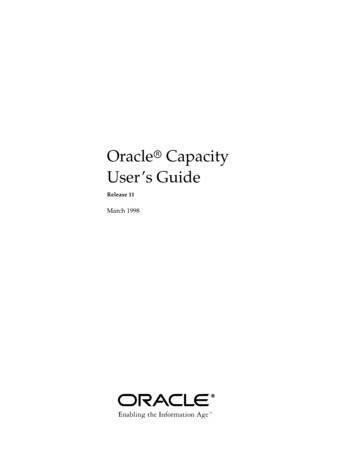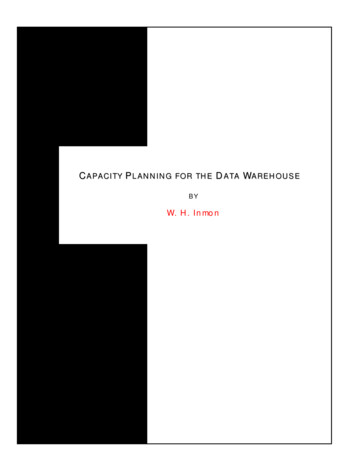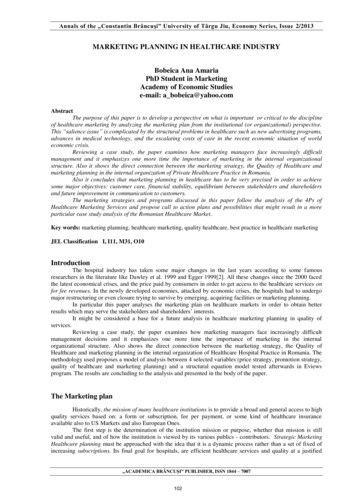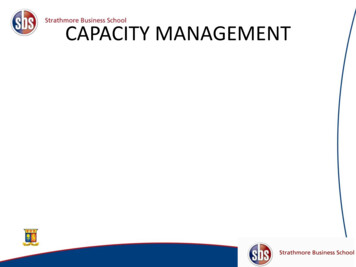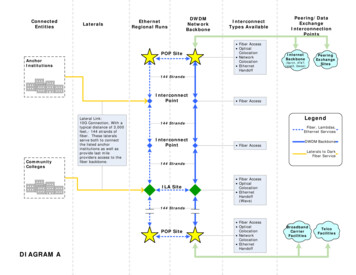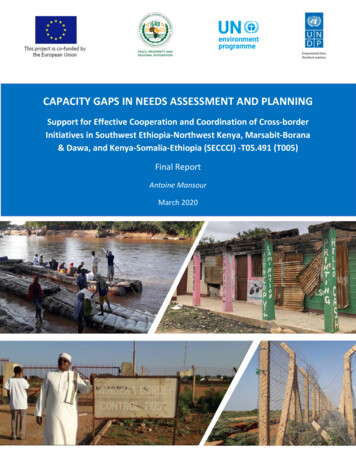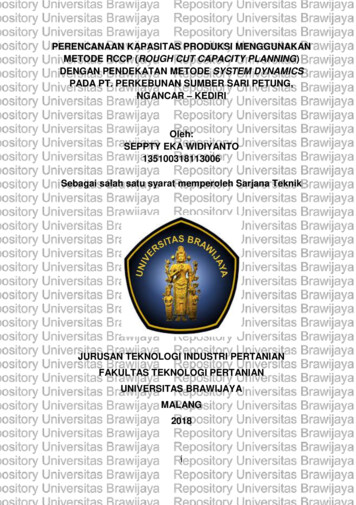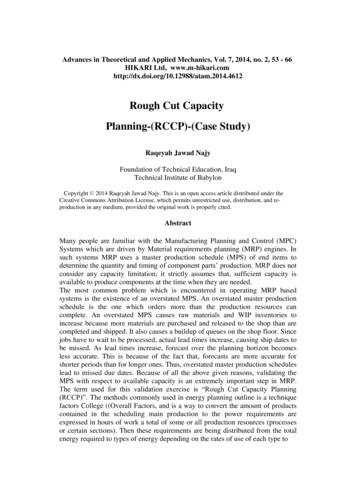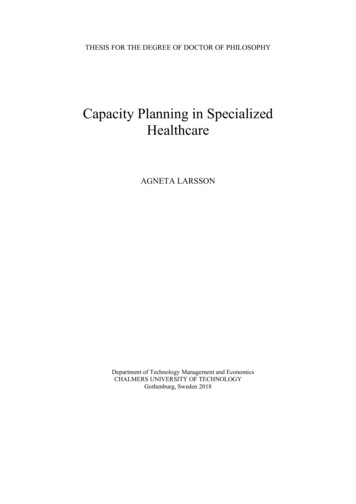
Transcription
THESIS FOR THE DEGREE OF DOCTOR OF PHILOSOPHYCapacity Planning in SpecializedHealthcareAGNETA LARSSONDepartment of Technology Management and EconomicsCHALMERS UNIVERSITY OF TECHNOLOGYGothenburg, Sweden 2018
Capacity Planning in Specialized HealthcareAGNETA LARSSONISBN 978-91-7597-829-1 AGNETA LARSSON, 2018Doktorsavhandlingar vid Chalmers tekniska högskolaNy serie nr 4510ISSN 0346-718XDepartment of Technology Management and EconomicsChalmers University of TechnologySE-412 96 GöteborgSwedenTelephone 46 (0)31-772 1000Printed by Reproservice, Chalmers University of TechnologyGöteborg, Sweden 2018
AbstractThe purpose of the thesis is to contribute to the knowledge of healthcare capacityplanning for effective use of resources. Capacity planning concerns the balancing ofthe demand for capacity with the available capacity of the production system. Withinthe healthcare setting, various studies report on the difficulties of providing healthcareservices according to patient demand. So, how can the balance between required andavailable capacity be achieved? How can we use our resources in accordance with whatthe patients need?The research presented in this thesis is based on five research questions which areanswered by the results of five case studies made at Swedish hospital departments. Theresearch questions concern how discrepancies between practice and capacity planningtheory may affect production performance; what a tactical capacity planning frameworkin healthcare would comprise; on what conditions rough-cut capacity methods (RCCP)are applicable in healthcare; the importance of including the knowledge of the surgeonswhen estimating required capacity; and if a team-based workflow can be employedwithout compromising production performance. The five research questions areanswered through five individual studies, all with a case study approach.The findings presented in this thesis provide knowledge regarding the structure ofcapacity planning processes; more specifically regarding the linkages between capacityplanning processes and their effects on production performance. Furthermore, theresearch provides a step-by-step framework for tactical capacity planning to improveproduction performance by keeping a long-term perspective when planning. Thetactical framework describes the structure of the capacity planning process and itsincluded activities. Additionally, the framework gives an account of requiredinformation for the planning process and proposes possible adjustment to balancedemand and supply. The output of the planning process is also described. To supportthe task of balancing required and available capacity two studies contribute to theinterpretation of patient demand into required capacity. First, conditions under whichrough-cut capacity planning methods are applicable in a healthcare setting are studiedand discussed. Second, the research extends existing knowledge of the estimation ofrequired surgery time, based on surgeons’ subjective knowledge of the patient conditionand thereby decreasing the risk of exceeding the scheduled surgery time. As concernsassessing available capacity, the research studies the use of a team-based work method,which shows an increase of productivity compared with a functionally dividedproduction system, while maintaining the same level of resources. In a capacityplanning perspective, the use of teams simplifies the assessment of available capacityby reducing the number of planning points from individual workers to the number ofteams.Keywords: Capacity planning, healthcare, resources, effectivenessI
II
List of appended papersThis thesis is a compilation of papers and consist of five appended papers. The papersare referred to by Romans numbers and are listed below. Further down, Table 1 liststhe appended papers and descries the contribution of the authors.Paper ILarsson, A., and Johansson, M. I. (2007) Healthcare Planning – a case study of asurgery department.An earlier version of this paper was published in Proceedings of PLAN conference, 56 sept. 2007, Jönköping, SwedenPaper IILarsson, A., Fredriksson A. (2018) Tactical Capacity Planning in HospitalDepartments. Accepted for publication in International Journal of Healthcare QualityAssurance.The article is scheduled for Volume 32, Issue 7, due Aug 2019Paper IIILarsson, A., Medbo, P., and Johansson, M.I. (2018) Conditions for using rough-cutcapacity planning methods within healthcareManuscript submittedPaper IVLarsson, A. (2013) The accuracy of surgery time estimations, Production Planning &Control, 24:10-11, 891-902, DOI: 10.1080/09537287.2012.666897Paper VLarsson, A., Johansson, M., Bååthe, F. and Neselius, S. (2012) Reducing throughputtime in a service organisation by introducing cross-functional teams. ProductionPlanning & Control, 23:7, 571-580, DOI: 10.1080/09537287.2011.640074III
IV
Table 1 Researcher contribution in each of the papersPAPER TITLEIHealthcarePlanning: A casestudy of a surgerydepartmentFIRSTAUTHORLarsson, A.COAUTHOR/SJohansson, M.RESPONSIBILITY OF THEAUTHORSPrincipal responsibility fordata collection.Second author responsible forthe design of the study.Shared responsibility for dataanalysis and writingTactical capacityplanning inhospitaldepartmentsLarsson, A.Conditions forusing rough-cutcapacity planningmethods withinhealthcareLarsson, A.IVThe accuracy ofsurgery timeestimationsVReducingthroughput time ina serviceorganisation byintroducing crossfunctional teamsIIIIIFredriksson,A.Principal responsibility forstudy design and datacollection.Shared responsibility for dataanalysis and writing.Medbo, PJohansson, M.Principal responsibility forstudy design, data collection.Shared responsibility dataanalysis with second authorand writing with third author.Larsson, A.-Sole authorLarsson, AJohansson, M.Bååthe, F.Neselius, S.Principal responsibility forstudy design (not designingwork method), datacollection, Sharedresponsibility of data analysisand writing with secondauthor.V
VI
AcknowledgmentDuring my many years as a PhD student I have had the privilege to work with greatpeople. All the medical staff at the hospitals and all the people in academia that I haveencounter during these years. It is hard to fit them all into a short text like this one, butthe two most influential persons in the PhD process are very special. These two are mysupervisors; Mats Johansson and Anna Fredriksson. I want to thank you both for all thetime and effort you have put into my studies and texts to improve the quality. Mats, Ihave said it before and I’ll say it again, your comments are razor sharp and it has foundmany of the weaknesses I have had in my thesis. You are the best at finding them andthere is no one like you. Anna, you are priceless with your encouragement andunderstanding. Thank you for all the suggestions that has solved many of my troubledtimes. Per Medbo, I must mention you explicitly. You have been such a joy to workwith, both in teaching and studies. Your much-needed humour and not least yourknowledge in statistical matters have been a great support in almost all my studies.Furthermore, I would like to thank all my colleagues through the years and wish I couldmention all of you by name since you all deserve to be mentioned. You have made thisjourney a true pleasure.We were five PhDs that started our PhD journey together a long time ago in 2007; LineaKjellsdotter Ivert, Christian Finnsgård, Robin Hanson, and Joakim Kalantari. You guyswill always be special to me.The personal acknowledgment will be to my husband and best friend; Simon E Larsson.‘If they were to write a book of the story of my life. They would have to mention youon every page they’d write. You are the other side of me’. I would like to add the namesof my treasures in life in my acknowledgments; Jennifer, Gabriella and Maximilian.The older I get the more I realise that you are the greatest people that have ever lived.There are no ones like you ever. I am so proud of you.VII
VIII
Table of contentAbstractList of appended papersAcknowledgment1 IntroductionIIIIVII11.1 Problem background . 11.2 Capacity management in healthcare. 21.3 Purpose . 41.4 Thesis outline . 52 Empirical setting72.1 The Swedish Healthcare system. 72.1.1 County council . 72.1.2 Healthcare providers . 82.1.3 Departments . 82.1.4 Units. 92.1.5 Activity .102.2 Patient demand .102.2.1 Volume .112.2.2 Mix.112.2.3 Urgency.122.2.4 Diagnostic uncertainty .122.3 Patient pathway .123 Frame of Reference153.1 Capacity .153.1.1 Healthcare resources .153.1.2 Differentiating capacity .163.2 Capacity Management.173.3 Capacity planning process.183.3.1 Hierarchy of planning processes .183.3.2 Tactical planning .20RQ 1:.223.3.3 Conducting the planning process .22RQ 2:.233.4 Estimation of Required Capacity .233.4.1 Required activities: Rough-cut capacity planning (RCCP) .23RQ 3:.253.4.2 Required activity time: Surgery time .25RQ 4:.273.5 Assessment of Available Capacity .273.5.1 Functionally divided production .273.5.2 Team-based work method.28RQ 5:.293.6 Positioning of research questions in Conceptual Framework .304 Methodology314.1 Research Process .314.2 Research design of the studies .324.2.1 Research design of Study 1 – Planning process discrepancies .334.2.2 Research design of Study 2 – Capacity planning process.344.2.3 Research design of Study 3 – Rough-cut capacity planning (RCCP) .344.2.4 Research design of Study 4 – Surgery-time estimation .354.2.5 Research design of Study 5 – Team-based work method .364.2.6 Summary of research design .374.3 Data collection in the studies .394.3.1 Data collection in Study 1 – Planning process discrepancies .39IX
4.3.2 Data collection in Study 2 – Capacity planning process.404.3.3 Data collection in Study 3 – Rough-cut capacity planning (RCCP) .424.3.4 Data collection in Study 4 – Surgery-time estimation .434.3.5 Data collection in Study 5 – Team-based work method .444.4 Data analysis of the studies .454.4.1 Data analysis in Study 1 – Planning process discrepancies .464.4.2 Data analysis in Study 2 – Capacity planning process .464.4.3 Data analysis in Study 3 – Rough-cut capacity planning (RCCP) .474.4.4 Data analysis in Study 4 – Study of surgery-time estimation .474.4.5 Data analysis in Study 5 – Team-based work method .484.5 Research quality .494.5.1 Credibility .504.5.2 Transferability.514.5.3 Dependability .514.5.4 Confirmability.525 Results555.1 Research question 1 .555.1.1 Structured procedures .555.1.2 Hierarchy of planning levels .565.1.3 Master planning and the master production plan .575.1.4 Forecasting and Prioritising .585.1.5 Summary of how planning process discrepancies affect performance .585.2 Research question 2 .605.2.1 Framework for tactical capacity planning.605.2.2 Applying the framework to different departments.615.3 Research question 3 .635.4 Research question 4 .665.5 Research question 5 .706 Discussion736.1 How do planning process discrepancies affect production performance? .736.1.1 The individual link between capacity planning discrepancies and productionperformance .736.1.2 Combined discrepancies’ link to production performance .756.2 What would a tactical capacity planning framework in healthcare comprise? .756.3 On what conditions are the rough-cut capacity planning methods (RCCP) applicablewhen estimating future required capacity? .766.4 Does the knowledge of the surgeons reduce the uncertainty of estimated requiredcapacity operation theatres? .786.5 How can a team-based working method support assessment of available capacity? .796.6 Effective use of resources .807 Conclusions and further research837.1 Conclusions drawn from included studies .837.2 Concluding remarks .847.3 Further research.85References89X
1 Introduction- What computer system should be purchased to achieve better control of the growingsurgery queues?This question was proposed by a Swedish healthcare manager and became the startingpoint for my research quest within the Swedish healthcare system. The questionillustrates the perplexity at the challenge of growing patient queues, which face manyhealthcare managers. This thesis concerns the balancing of the demand for healthcareresources with the supply of the same, namely, capacity planning in healthcare.1.1 Problem backgroundThe Swedish healthcare system is currently a relatively well-functioning system withdeficiencies in certain areas. A publication released by the Swedish Ministry of Finance(Ministry of Finance, 2010) and statistics from the OECD Economics Department (Rae,2005; OECD, 2016) stated that the Swedish healthcare system is performing well withregard to medical quality. However, one of the main concerns with the system is theavailability of specific specialist treatment (Rae, 2005; OECD, 2016). The often-usedexplanation of experiencing low availability refers to a lack of capacity to explain longpatient waiting times. With regard to the quantity of doctors, Sweden has a relativelyhigh ratio of doctors per citizen, although the number of doctor visits is low (Almlöf etal., 2013; OECD, 2016). Compared to other Nordic countries, Swedish hospitals havedistinguished themselves by showing the lowest productivity (Stiernstedt et al., 2016b).The low productivity is visible as the production rate remains stable whilst the amountof staff continues to increase. A challenge facing the Swedish healthcare system is alsothe change in demographics. The elderly share of the population is steadily increasing,as well as the expected lifespan (Rae, 2005; Stiernstedt et al., 2016b; OECD, 2016).For the healthcare sector, the elderly population generates higher expenditures, aselderly patients tend to require more medical services than their younger counterparts(Etzioni et al., 2003). The demographic change leads to a smaller share of thepopulation that is of working age. This leads to a decrease in funding through taxes anda decrease in the available workforce. The challenge of a changing demographicrequires a different approach to the use of resources and to the traditional approach ofincreasing the amount of resources when facing an increase in demand (Stiernstedt etal., 2016b).Interventions addressing problems with low healthcare availability can be executed indifferent ways. Implementing incentives can stimulate the development of healthcareproduction in a desired direction. Regulations can be used to direct the healthcareproviders towards increasing the availability and desired production performance(Swedish Association of Local Authorities and Regions, 2017; Stiernstedt et al.,2016a). One example of such a regulation is the Swedish ‘healthcare guarantee’implemented in 2010 (The National Board of Health and Welfare, 2018a), whichdemanded healthcare providers to provide the first visit at the specialist care withinthree months after the referral is received. The provider is thereafter required to offerspecialist treatment within an additional three months after the first visit. In situationswhere the provider is unable to provide the care, the regulation enables the patients toseek specialist care from another healthcare provider, at the expense of the initialprovider. This regulation is intended to motivate the providers to ensure that their1
production processes perform according to the regulated delivery time. Interventionsthat focus on organisational and structural changes in the healthcare system are anotherway to improve availability. In a report by Stiernstedt et al. (2016b), a differentiationof care is proposed, focusing the care provided by the hospitals on the very ill patients.According to this report, the primary care providers are to be empowered to treat abroader variety of ailments, including less complicated specialist care. The suggestionin the report is to strengthen the primary care units with staff from differentspecialisations. Through a reorganisation of the healthcare system, specialist care isdesigned to be closer to the patients and, thereby, leave costly hospital care to the veryill patients. Interventions based on medical and technological research also contributeto the efficiency of providing specialty care, such as new treatment methods ordevelopments in medical technology (e.g. Stiernstedt et al., 2016a; Region Skåne,2016). There are various options available to address the present challenges of lowavailability in Swedish healthcare. This research focuses on the capacity planning theuse of resources within the production system at hand. In the situation that the researchis studying, strategically decisions are made and forms the frame in which the capacityplanning is performed. Strategic decisions that are made includes that the regulatedproduction goals are stated, the production system and processes are designed, and themedical and technological methods are chosen and implemented.To illustrate the focus that this thesis has in contributing to better availability of care,the insights compiled by two large studies of the Swedish healthcare system are used(Stiernstedt et al., 2016b; Ackerby et al., 2010). The studies revealed that the notionthat the cause of the problem is a lack of resources is most often not true, but rather theway they are used, namely, ineffectively. This phenomenon is not specifically Swedish,as it has also been reported in research performed in other countries (e.g. Tai andWilliams, 2008). According to Tai and Williams (2008), the lack of balance betweendemand and supply of healthcare services is not solely due to a lack of capacity but alsoto inappropriate capacity allocation. Thus, in a situation in which the amount ofcapacity is not the cause of problem, the question is: How can the capacity be managedmore effectively?1.2 Capacity management in healthcareThe task concerning establishing, measuring, monitoring and adjusting limits or levelsof capacity is referred to as capacity management, according to the Association forSupply Chain Management (APICS, 2005). This description of capacity management(further elaborated on in Chapter 3), within the context of managing a productionsystem, aims at ensuring available capacity at the right time and place in relation to therequired capacity. The required capacity is derived out of demand, and the availablecapacity is generated by the resources of the production system. Finding the balancebetween required capacity and available capacity is achieved through capacity planningprocesses (Jonsson and Mattsson, 2009). In a situation where there is no capacityplanning, achieving the stated goals occurs more by chance than by managing thesystem properly. Planning the usage of capacity in the production system requires theability to both predict the amount of the required capacity and assess the availablecapacity, that is, to meet the demand for capacity. To balance these two capacities, thereare various planning and control processes to use at different planning horizons (Slacket al., 2007). For example, capacity planning can be performed either with a short-termplanning focus to solve the balance of capacities over the tasks performed in a week orwith a longer perspective, measured in years, to ensure the balance of capacities (e.g.2
Jonsson and Mattsson, 2009). One way of structuring the hierarchy of planningprocesses is the manufacturing planning and control system (MPC) (Jonsson andMattsson, 2009). This way of structuring the planning processes is the underlyingstructure on which the research is based.The way to manage a production system depends on the characteristics of theproduction system and the characteristics of the products or services that are beingproduced (Jonsson and Mattsson, 2003; Jacobs et al., 2011). In other words, it isdependent on the context in which the system is working. This research is performedwithin the Swedish healthcare context. In the Swedish system, the providers areassigned a geographic area with a population to provide with care. The healthcareprovider is expected to meet all demand generated by the geographic area and is notentitled to refuse any citizen care. The aim of the capacity planning is, therefore, tobalance all demand requiring capacity with the available capacity at hand. Imbalancesbetween required and available capacity may be caused by an insufficient amount ofcapacity, leading to patient waiting time or excess of capacity, the latter of which isrelated to costs and waste of capacity. The amount of capacity may be appropriate butstill cause an imbalance due to the timing of the availability of the capacity. Thecapacity planning process provides a sequence of activities and decisions to ensure thatthe use of resources is as intended. Instead of letting the production continue ‘as usual’,decisions regarding what to produce and when become a consciously made choicebased on agreed upon production plans. For service organisation, a statement made bySasser (1976) described a manager’s role as: ‘Managing demand and supply is a keytask of the service manager’. In Figure 1, the task of the managers has been illustrated.The figure depicts the task of the capacity planning process as balancing the requiredcapacity with the available capacity by choosing ways to adjust the balance. Therequired capacity is derived prior to the capacity planning process and is depicted aspatient demand in Figure 1.The patient demand consists of forecasts and the patientsalready within the production system (Jonsson and Mattsson, 2009). On the right-handside of Figure 1 is the supply of resources that provides the available capacity. In thisresearch, these resources are already set, and the changes in the number of resourcesrely on the adjustment phase of Figure 1. Hereafter in this thesis, Figure 1 is of centralimportance and depicts the conceptual model that is associated with the studies andresults of the research.Figure 1. Capacity planning: the central conceptual model of the thesisA fundamental challenge of achieving balance between required and available capacityresides in the fact that the number of patients is seldom a static amount, but rather astochastic variable (Silvester et al., 2004). The number of patients is not the only thing3
that varies, but also the mix of diagnoses, patient conditions and severity. A similarreasoning can be stated about the capacity of the resources that are used in theproduction system, as the resources primarily consist of the skills of individualprofessionals with varying levels of competence and experience. Therefore, citing whatSasser said in 1976: ‘Managing demand and supply is not a single event, but rather anongoing monitoring and adjusting process to maintain a balance between both amountsof capacity’. Capacity planning and management of the production system is aniterative process and can be expected to be a central and a continuous occurring eventwithin healthcare management.1.3 PurposeThe ability of balancing demand with supply resides in an organisation’s processes ofcapacity planning. To better adjust the capacity of the resources according to thedemand of the patients, this thesis focuses on the balancing of the two capacities.Finding balance is a prerequisite for having an effective use of resources. ‘Effective
II Tactical capacity planning in hospital departments Larsson, A. Fredriksson, A. Principal responsibility for study design and data collection. Shared responsibility for data analysis and writing. III Conditions for using rough-cut capacity planning methods within healthcare Larsson, A. Medbo, P Johansson, M. . Principal responsibility for
